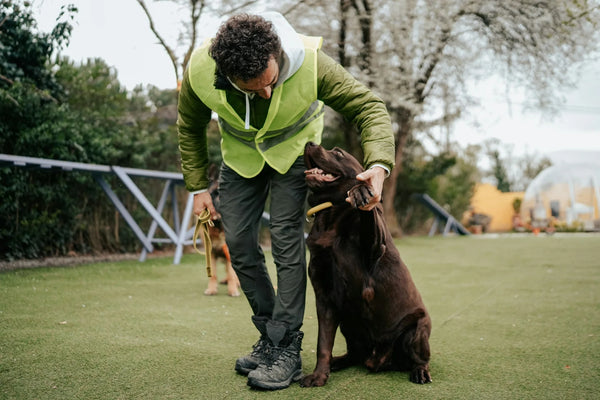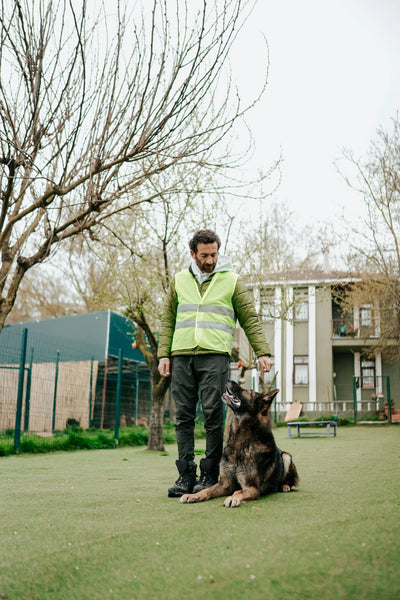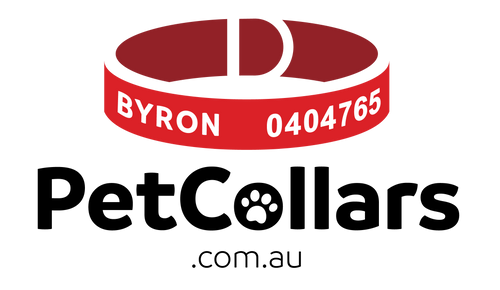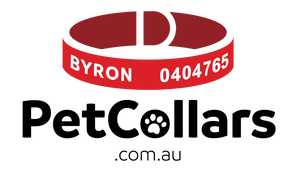 Dog Reactivity Training: What You Should Know
Dog Reactivity Training: What You Should Know
Welcome to our comprehensive guide on dog reactivity training. If you've ever felt embarrassed or overwhelmed by your dog's reactive behaviour during walks, you're certainly not alone. In fact, approximately 75% of dog owners report that their furry companions display some signs of reactivity.
This widespread issue can manifest in various forms, from barking and lunging to more subtle signs of discomfort. However, with the right training and tools, reactivity can be effectively managed, ensuring a more peaceful and enjoyable experience for both you and your dog.
In this blog post, we'll cover everything you need to know about how to train a reactive dog, dog aggression training, and how to socialise a reactive dog. We aim to provide you with the knowledge and strategies needed to address reactivity, fostering a stronger bond between you and your beloved pet.
Understanding Dog Reactivity
Dog reactivity is a behavioural issue that presents a significant challenge in dog reactivity training. It occurs when a dog excessively responds to specific stimuli in their environment, such as other dogs, people, loud noises, or even inanimate objects. These reactions can manifest as barking, lunging, growling, or snapping, often leading to misunderstandings about the dog's intentions.
It's crucial to recognise that reactive behaviour is typically rooted in fear, anxiety, or frustration, rather than a genuine desire to harm. This distinction is key when undertaking reactive dog training, as it shifts the focus from punitive measures to understanding and addressing the underlying emotional triggers.
Reactivity VS Aggression

Misinterpreting reactive behaviour as aggression can lead to inappropriate responses, worsening the issue. Aggression in dogs is characterised by an intent to threaten or cause harm, and it requires a different approach, such as specific dog aggression training techniques.
Reactivity:
- Definition: Reactivity in dogs is an overreaction to certain environmental stimuli, such as other dogs, people, or noises. It is often characterised by barking, lunging, or growling.
- Root Cause: Reactivity is typically rooted in fear, anxiety, or frustration. It is an emotional response to a perceived threat or overwhelming situation.
- Goal of Training: The goal of reactive dog training is to help the dog feel more comfortable and confident in the presence of their triggers, reducing their need to react excessively.
- Dog Reactivity Training Approach: Training a reactive dog often involves desensitisation and counter-conditioning techniques. In these techniques, the dog is gradually exposed to its triggers in a controlled manner while being rewarded for calm behaviour.
Aggression:
- Definition: Aggression in dogs is behaviour that is intended to threaten or harm another creature. It can include biting, snapping, and growling with a clear intent to cause harm.
- Root Cause: Aggression can stem from various factors, including territorial behaviour, fear, dominance, or pain. It is a more complex issue than reactivity and often requires a thorough behavioural assessment.
- Goal of Training: The goal of dog aggression training is to address the underlying causes of aggression and teach the dog alternative, acceptable behaviours when faced with their triggers.
- Dog Aggression Training Approach: Training an aggressive dog typically requires a more specialised approach, often involving a professional dog trainer or behaviourist. It may include behavior modification techniques, management strategies, and in some cases, medication.
Causes of Dog Reactivity in More Detail

Identifying the underlying causes of your dog's reactivity is the first step toward effective reactive dog training. Some common factors that contribute to reactivity include:
- Genetics: Certain breeds may be more prone to reactive behaviour due to their genetic makeup. For example, breeds originally bred for guarding or herding (like the Australian Shpherds or Border Collies) may have a higher tendency to react to perceived threats.
- Lack of Socialization: Dogs that haven't been adequately socialized during their critical socialisation period (typically between 3 and 14 weeks of age) may become reactive. They might not have learned how to interact appropriately with other dogs, people, or various environments. Take your puppy out to get them to socialize to prevent the need for dog reactivity training later on.
- Past Negative Experiences: Traumatic events or negative experiences in a dog's past can lead to reactivity. For example, a dog that has been attacked by another dog may become reactive when encountering dogs in the future.
- Frustration: Sometimes, reactivity stems from a dog's frustration at being unable to reach something they want, like another dog or a person. This is often seen in dogs that are overly excited and have poor impulse control.
- Lack of Training: Dogs that haven't been taught how to behave calmly in different situations may resort to reactive behaviour as a default response.
Understanding these causes is essential for formulating an effective dog training plan for reactive dogs. By addressing the root of the issue, you can help your dog learn to respond more calmly and confidently in situations that previously triggered their reactivity.
Dog Reactivity Training Techniques

When it comes to managing and reducing reactivity in dogs, several training methods have proven to be effective. These techniques focus on changing the dog's emotional response to triggers and reinforcing desirable behaviours. Let's explore some of the most commonly used reactive dog training techniques.
Desensitisation and Counter-Conditioning
Desensitisation and counter-conditioning are cornerstone techniques in reactive dog training. Desensitisation involves gradually exposing your dog to their triggers at a level that doesn't provoke a reactive response.
This might mean starting with the trigger at a distance or in a diluted form. Over time, you can gradually increase the intensity of the exposure as your dog becomes more comfortable.
Counter-conditioning in dog reactivity training is similar to desensitisation. It involves changing your dog's emotional response to a trigger by pairing the presence of the trigger with something positive, like treats or praise.
For example, if your dog reacts to other dogs, you would give them a treat every time they see a dog from a distance where they don't react. Over time, your dog will start to associate the sight of other dogs with positive experiences, reducing their reactivity.
Positive Reinforcement Dog Reactivity Training

Positive reinforcement training is a powerful tool in addressing dog reactivity. This approach focuses on rewarding your dog for displaying calm and non-reactive behaviour in the presence of their triggers. Rewards can be in the form of treats, praise, toys, or anything else your dog finds motivating.
The key is to reinforce the behaviour you want to see, such as looking at you instead of lunging at another dog or remaining seated when a visitor enters the house. By consistently rewarding these positive behaviours, you teach your dog that good things happen when they remain calm and composed. Over time, this can lead to a significant reduction in reactive behaviour.
Incorporating these reactive dog training techniques into your training regimen can help your dog learn to manage their reactivity more effectively. It's important to remember that progress may take time, and patience is crucial.
How to Socialize a Reactive Dog: A Comprehensive Guide
Socialisation is crucial for all dogs, but it's especially important for reactive dogs undergoing dog reactivity training. Proper socialisation can help reduce fear and anxiety, making your dog more confident and well-adjusted.
However, socialising a reactive dog requires a careful and considerate approach. In this section, we'll discuss safe socialisation practices for reactive dogs and how to create positive social experiences for your furry friend.
Safe Socialisation Practices
When socialising a reactive dog undergoing reactive dog training, it's essential to introduce them to new experiences gradually. Start with less stressful situations and slowly increase the difficulty level as they become more comfortable.
This gradual exposure can help your dog learn to cope with new stimuli without becoming overwhelmed. For example, if your dog is reactive to other dogs, a dog beach might not be a good idea in the beginning stages of its dog reactivity training.
Use of Muzzles and Leashes

For the safety of your dog and others, it's advisable to use a muzzle and a sturdy lead during socialisation sessions. A well-fitted muzzle allows your dog to breathe, pant, and drink water while preventing them from biting. A strong training leash provides you with control over your dog's movements, ensuring you can quickly intervene if necessary.
Choosing the Right Setting
Selecting the appropriate setting for socialisation is key. Opt for quiet, controlled environments where you can easily manage your dog's reactions. This might include empty parks, quiet streets, or controlled indoor spaces with fewer distractions and potential triggers.
Monitoring Body Language
Pay close attention to your dog's body language throughout the socialisation process. Look for signs of stress or anxiety, such as panting, yawning, lip licking, or a tucked tail.
If you notice any of these indicators, it's best to remove your dog from the situation and give them a break. It's important to keep socialisation sessions positive and end them before your dog becomes too stressed.
By following these guidelines and using a careful, gradual approach, you can help your reactive dog undergoing dog reactivity training become more comfortable in various situations. Remember that patience and consistency are key, and seeking the assistance of a professional dog trainer who specialises in reactive dog training in Brisbane, Melbourne, or your local area can provide valuable support and guidance.
Training Reactive Dog: Tips for Pet Owners
Dealing with a reactive dog can be challenging, but with the right approach, you can help your furry friend become more comfortable and confident in various situations. Here are some practical tips for managing your reactive dog at home:
Remain Calm and Confident During Walks

Dogs can pick up on their owner's emotions, so it's essential to stay calm and composed when walking your reactive dog. Avoid tensing up or reacting nervously to potential triggers, as this can escalate your dog's anxiety.
Use High-Value Treats to Reward Good Behavior
Positive reinforcement is key to training a reactive dog. When your dog displays calm behaviour or successfully ignores a trigger, reward it with its favourite treats. This helps reinforce the desired behaviour and encourages it to remain calm in similar situations in the future.
Avoid Situations That You Know Will Trigger Your Dog's Reactivity
Prevention is often the best approach when dealing with a reactive dog. If you know certain situations or environments are likely to trigger your dog, try to avoid them or create distance to reduce the likelihood of a reactive outburst.
Supporting Your Reactive Dog Training Journey
At PetCollars AU, we understand the challenges of dog training for reactive dogs. That's why we offer a range of personalised dog harnesses, collars and leads designed to help you manage your dog's reactivity.

Our products are crafted with your dog's comfort and safety in mind, providing a secure and comfortable fit for your furry friend. One key feature of our personalised dog and cat accessories is the ability to customise them with your dog's name and contact details.
This added security measure ensures that your dog can be easily identified if it ever becomes separated from you, providing peace of mind during outdoor reactivity dog training sessions, walks or outings. Our collars and harnesses are available in a variety of styles, colours, and sizes to suit your dog's individual needs.


